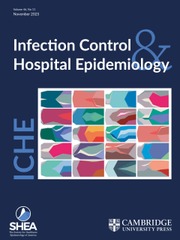Article contents
Analysis of Infection Control Surveillance Data in a Long-Term–Care Facility: Use of Threshold Testing
Published online by Cambridge University Press: 02 January 2015
Abstract
To describe long-term trends in nosocomial infection rates and the threshold testing method for evaluating nosocomial sur veillance data in a long-term–care facility (LTCF).
Descriptive epidemiology of prospectively collected infection control sur veillance data and application of threshold testing for detecting possible outbreaks. Threshold testing uses the binomial distribution to calculate probabilities of infection frequency at selected endemic levels (mean number of infections per month) and compares these probabilities to obser ved infection frequency.
One hundred twenty-bed LTCF located within a public, university-affiliated hospital.
The study period was 1987 through 1994. Yearly endemic levels of specific types of infection were calculated and threshold levels were determined using a previously published method. In this study, a probability of P=.01 was chosen to determine the threshold at a specific endemic level; if the observed number of infections in a month reached or exceeded the threshold level, the likelihood that this occurred by chance alone was 1% or less.
None.
The overall mean nosocomial infection rate ranged from three to five episodes per 1,000 resident care days per year; mean yearly rates from 1990 onward were higher and more stable than those from 1987 to 1989. The most common infections identified were lower respiratory tract, skin and soft tissue, urinary tract, and conjunctivitis. For each of these infections, threshold levels were calculated periodically, using only the monthly frequency of infection. Despite variations in the yearly mean endemic level of various infections, threshold levels were stable except for skin and soft-tissue infection.
Threshold testing for analysis of infection control sur veillance data in the LTCF setting is straightfor ward and does not require knowledge of statistics, special computer software, or calculation of rates; given the stable population in the typical LTCF, threshold testing can be based on variations in the monthly count of infections and provides an objective evaluation of surveillance data and a method to identify when outbreaks may be occurring.
Information
- Type
- Original Articles
- Information
- Copyright
- Copyright © The Society for Healthcare Epidemiology of America 1996
References
- 2
- Cited by

